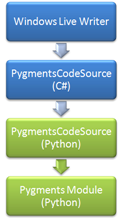In my last
post,
I added support for custom attribute positional parameters . To finish
things off, I need to add support for named parameters as well. Custom
attributes support named parameters for public fields and settable
properties. It works kind of like C# 3.0’s object
initalizers.
However, unlike object initalizers, the specific fields and properties
to be set on a custom attribute as well as their values are passed to
the CustomAttributeBuilder
constructor.
With six arguments – five of which are arrays – it’s kind of an ugly
constructor. But luckily, we can hide it away in the make_cab function
by using Python’s keyword arguments
feature.
def make_cab(attrib_type, *args, **kwds):
clrtype = clr.GetClrType(attrib_type)
argtypes = tuple(map(lambda x:clr.GetClrType(type(x)), args))
ci = clrtype.GetConstructor(argtypes)
props = ([],[])
fields = ([],[])
for kwd in kwds:
pi = clrtype.GetProperty(kwd)
if pi is not None:
props[0].append(pi)
props[1].append(kwds[kwd])
else:
fi = clrtype.GetField(kwd)
if fi is not None:
fields[0].append(fi)
fields[1].append(kwds[kwd])
else:
raise Exception, "No %s Member found on %s" % (kwd, clrtype.Name)
return CustomAttributeBuilder(ci, args,
tuple(props[0]), tuple(props[1]),
tuple(fields[0]), tuple(fields[1]))
def cab_builder(attrib_type):
return lambda *args, **kwds:make_cab(attrib_type, *args, **kwds)
You’ll notice that make_cab now takes a third parameter: the attribute
type and the tuple of positional arguments we saw last post. This third
parameter “**kwds” is a dictionary of named parameters. Python
supports both positional and named parameter passing, like VB has for a
while and C# will in 4.0. However, this **kwds parameter contains all
the extra or leftover named parameters that were passed in but didn’t
match any existing function arguments. Think of it like the
params of named
parameters.
As I wrote earlier, custom attributes support setting named values of
both fields and properties. We don’t want the developer to have to know
if given named parameter is a field or property, so make_cab iterates
over all the named parameters, checking first to see if it’s a property
then if it’s a field. It keeps a list of all the field / property infos
as well as their associated values. Assuming all the named parameters
are found, those lists are converted to tuples and passed into the
CustomAttributeBuilder
constructor.
In addition to the change to make_cab, I also updated cab_builder
slightly in order to pass the **kwds parameter on thru to the
make_cab function. No big deal. So now, I can add an attribute with
named parameters to my IronPython class and it still looks a lot like a
C# attribute specification.
clr.AddReference("System.Xml")
from System.Xml.Serialization import XmlRootAttribute
from System import ObsoleteAttribute, CLSCompliantAttribute
Obsolete = cab_builder(ObsoleteAttribute)
CLSCompliant = cab_builder(CLSCompliantAttribute)
XmlRoot = cab_builder(XmlRootAttribute)
class Product(object):
__metaclass__ = ClrTypeMetaclass
_clrnamespace = "DevHawk.IronPython.ClrTypeSeries"
_clrclassattribs = [
Obsolete("Warning Lark's Vomit"),
CLSCompliant(False),
XmlRoot("product", Namespace="http://samples.devhawk.net")]
# remainder of Product class omitted for clarity
As usual, sample code is up on my
SkyDrive.
Now that I can support custom attributes on classes, it would be fairly
straightforward to add them to methods, properties, etc as well. The
hardest part at this point is coming up with a well designed API that
works within the Python syntax. If you’ve got any opinions on that, feel
free to share them in the comments, via
email, or on the IronPython mailing
list.

